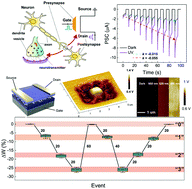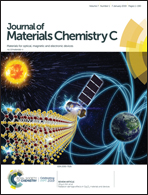Artificial synapses emulated through a light mediated organic–inorganic hybrid transistor†
Abstract
Neuromorphic computing could tackle the inherent limitations of traditional von Neumann architecture in devoted machine learning applications. Nevertheless, implementation of a transistor-based artificial synapse which is the fundamental building block for mimicking the functions of biological synapses remains challenging owing to the nonlinear and asymmetric weight update protocol and fast saturation within the initial few pulses. Here, a three-terminal photoactive synapse is proposed based on black phosphorus (BP)–ZnO hybrid nanoparticles (NPs) with a combination of an electronic mode and a photoactive mode. By the electronic mode, the channel conductance can be manipulated by charge trapping inside the thin BP–ZnO NPs which ensures an enlarged variation margin and the realization of 4 synaptic weight levels, while optical modulation of the excitatory and inhibitory synaptic weights with symmetry and linearity variation was realized, since an extended energy threshold of photon absorption and accelerated dissipation of excitons can be achieved in the BP–ZnO hybrid NPs. Crucially, we can modulate the synaptic weight simply by varying the wavelength of the light source (365, 520, and 660 nm) and achieve an extended synaptic weight change of 400% within 10 optical pulses. This study proposes an extremely simple and powerful system with multiple forms of synaptic plasticity resembling an analogue of a natural biological synapse due to the broadband response of the BP–ZnO hybrid NPs.



 Please wait while we load your content...
Please wait while we load your content...